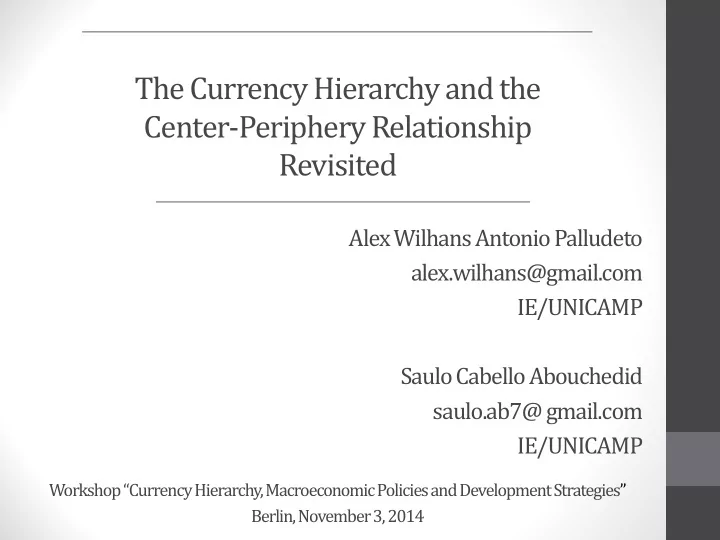

The Currency Hierarchy and the Center-Periphery Relationship Revisited Alex Wilhans Antonio Palludeto alex.wilhans@gmail.com IE/UNICAMP Saulo Cabello Abouchedid saulo.ab7@ gmail.com IE/UNICAMP Workshop “Currency Hierarchy, Macroeconomic Policies and Development Strategies” Berlin, November 3, 2014
P RESENTATION O UTLINE 1. Introduction; 2. Center-periphery relationship: Latin American Structuralism and Dependency theories; 3. The currency hierarchy in contemporary capitalism; 4. A "new" dimension of the center-periphery relationship; 5. Concluding Remarks; 6. Future Research Agenda. 2
1. I NTRODUCTION This paper aims to reassess the center-periphery relationship in light of recent developments taking place in the International Monetary System (IMS), with particular emphasis on the currency hierarchy. 3
2. L ATIN A MERICAN S TRUCTURALISM AND D EPENDENCY THEORIES Latin American Structuralism: A dualistic conception of economic organization; Examination of three structural tendencies: Unemployment; External imbalance; Deterioration of the terms of trade; Development strategy: Import Substitution Industrialization (ISI). Dependency Theories: It combines elements of structuralism and marxism; Basics features: The historical perspective of the center-periphery relationship; Unequal exchange; Rejection of dualism; Non-viability/autonomy of the national bourgeoisie. Therefore, for these theories of center-periphery relationship, this is determined by 4 the conformation of the productive sphere worldwide or, in other words, by the nature of the productive articulation that a country holds with the international economy.
3. T HE CURRENCY HIERARCHY IN CONTEMPORARY CAPITALISM International Monetary System (IMS): 5
3. T HE CURRENCY HIERARCHY IN CONTEMPORARY CAPITALISM The position of each currency in the IMS is determined by its ability to perform its functions of unit of account, means of payment, and store of value internationally; The determinants of currency hierarchy: The size of the national economy and integration with the world economy; Geopolitical power; Political will (e.g, the strong dollar policy); Strong and/or favorable institutions; "Responsible" economic policy and good macroeconomic performance. Financial asymmetry: two dimensions Capital flow directed to emerging countries is determined by external dynamics to those countries; Marginal insertion of peripheral countries in global capital flow; Liquidity of the key currency x market liquidity. 6
3. T HE CURRENCY HIERARCHY IN CONTEMPORARY CAPITALISM The volatility of the exchange rate in emerging countries generates significant volatility in interest rates in these countries; Currency hierarchy and interest rate in the current IMS: 7
4. A “ NEW ” DIMENSION OF THE CENTER - PERIPHERY RELATIONSHIP The currency hierarchy limits the ability of peripheral countries to overcome the socioeconomic conditions in which they find themselves, because it reduces the degree of policy autonomy; Original concept: macroeconomic asymmetry the currency hierarchy and financial asymmetry associated with it "(...) implies macroeconomic asymmetry, which relates to different degrees of policy autonomy of the countries that comprise the system."(Prates, 2002, p. 150). When restricted to the economic domain, the policies about which the literature refers are, in general, macroeconomic: exchange, monetary, and fiscal. 8
4. A “ NEW ” DIMENSION OF THE CENTER - PERIPHERY RELATIONSHIP In this context, the literature references several negative impacts on policy autonomy of peripheral countries, with specific regard to financial globalization, but rarely is the analysis related to currency hierarchy: Fear of floating; Currency mismatch; Sudden stops; Original sin ; Debt intolerance. These effects of currency hierarchy reached several emerging countries in the second half of the 1990s. It has led to some changes in the macroeconomic policy: Changes in the exchange rate regime (dirty floating); The "precautionary demand" for international reserves; Capital Management Techniques. 9
4. A “ NEW ” DIMENSION OF THE CENTER - PERIPHERY RELATIONSHIP The effects of the currency hierarchy, however, are not limited to exchange, or monetary and fiscal policies; The currency hierarchy in a context of financial globalization also limits the space for other forms of intervention in the economy, such as productive and technological development policies. Exchange and interest rates are key economic variables, as their levels, fluctuation, and the way they are managed by domestic authorities, end up affecting the entire economic system. The feasibility and effectiveness of sectoral development policies, such as industrial, agricultural, technological development, and innovation policy, depend largely on the behavior of these variables and how the authorities act upon them directly and indirectly. 10
4. A “ NEW ” DIMENSION OF THE CENTER - PERIPHERY RELATIONSHIP Currency Hierarchy + Financial Asymmetry Therefore, it is desirable to expand the concept of macroeconomic asymmetry Policy Space (Unctad and South Centre). Four examples: There is a less favorable environment for private investment and government planning; Difficulty in reconciling a smaller monetary policy autonomy with the objective of industrial policy, technological development, etc.; The FX reserve accumulation, a strategy adopted by many countries, as already noted, results in additional pressure on public finances, and also reduces the 11 potential for other development policies; The pair floating exchange system-inflation targeting fails to succeed in increasing the degree of policy autonomy.
5. C ONCLUDING R EMARKS The center-periphery relationship analyses seem to neglect the global financial dimension. The dismantling of the Bretton Woods monetary and financial system and the current conformation of IMS left the capitalist periphery subject to the deleterious effects of the currency hierarchy. Given this framework, integrating monetary and financial dimensions of global capitalism into the center-periphery relationship framework is not only desirable, but necessary. This proposal creates an important research agenda, focused on empirical analysis of the examples cited. 12
6. F UTURE R ESEARCH A GENDA Next paper: Quantitative and qualitative analysis of the fiscal cost resulting from the FX reserve accumulation (Brazil case) based on the theoretical approach outlined above. PhD research project: General objective: Analyze the exchange policy in a currency hierarchy framework and propose a taxonomy for exchange rate policy in emerging countries, that seeks to relate the intervention and the transmission channels with the specificities of each country (institutional, financial markets, macroeconomic regime, characteristics of the financial account and its relationship with the current transactions account, etc). Contribution of Capital Management Techniques; Country case studies. 13
Recommend
More recommend